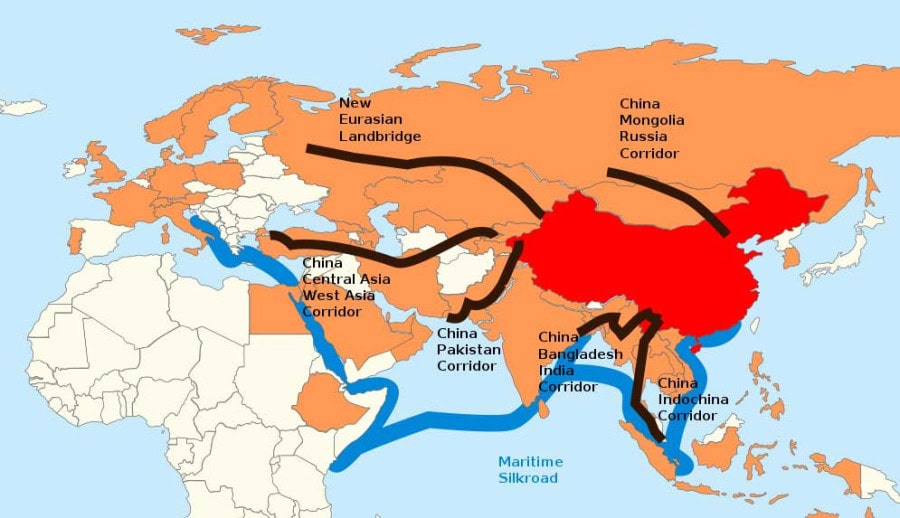The People’s Republic of China is celebrating its 75th anniversary this week. The Chinese odyssey remained full of economic turbulence and ultimately became the world’s 2nd largest economy. It seems that international media, especially The Financial Times, The World Street Journal, CNBC and CNN have internationally published anti-China and China’s Collapse articles to transship its 75th anniversary. However, China’s macro-economy latest figures have outperformed all the regional as well as international countries. Thus the newly coined theory of “China-USA Same Mirror” has no similarities because China always stands for just economic globalization, international cooperation and openness negating all kinds of conspiracy theories and self-claimed economic equations.
Significantly, the Chinese BRI has successfully connected Asia with Africa and Europe via land and maritime networks. Remarkably, the BRI has attracted at least three quarters of the world’s countries and 32 international organizations.
According to official figures so far, the BRI has established at least 3,000 cooperation projects, leading to the creation of more than 420,000 local employment opportunities. As a result, an estimated 40 million people have ultimately been lifted out of poverty.
China’s development over the past 75 years has been a blessing to global development, prosperity and peace. China has invested US$25.4 billion in direct projects in Pakistan, creating 236,000 jobs, generating 8,000 megawatts of electricity, and building 510 kilometers of highways and 886 km of the national electricity grid.
Also, about 28,000 Pakistani students are studying in China and more than 20,000 Pakistanis are learning Chinese. Moreover, the incumbent government is considering sending 200,000 students to various universities of China to learn latest discipline of digitalization and Artificial Intelligence
The comparative study of Chinese economic development reveals that in 1949, China was one of the world’s poorest countries. However, China has moved from an impoverished, underdeveloped country to a global economic giant and a major player in global governance. China is one of the largest and most powerful economies on the planet. Additionally, over the past two decades, China has been the world’s biggest manufacturing superpower. Moreover, China’s remarkable footprints are in the global economy, infrastructure, world peace, science and technology, global governance, development and human progress in line with global development goals which shows its collaborative comprehensive international cooperation.
According to the National Science Foundation (NSC), China has surpassed the US in scientific patents and published reports. Furthermore, the Australian Strategic Policy Institute (2034) reconfirms China’s leading role and position in advanced technologies heading the US in 37 out of 44 areas. Especially, the NSC finds that China leads the US in the more critical areas, including nano-manufacturing, 5G, robotics and hypersonic missiles, and has six times as many patents in artificial intelligence. China's significant lead has been attributed to holistic and comprehensive philosophies, policies, plans and projects which vividly reflects its diversified expertise in modernization, digitalization, artificial intelligence, service industry & trade, culture & tourism and qualitative industrialization.
China has successfully pulled more than 800 million people out of poverty. Evidently, China is on track to becoming the strongest growth engine globally with its contribution to the global GDP standing at around 18 percent.
The latest economic data has confirmed that Chin’s GDP grew by 5.2 percent in 2023. It is propped through constant economic structural reforms, opening-up, modernization, transparency leaving the door open to foreign businesses. It is the top trading partner with over 125 countries across the world. In 2022, China maintained its position as the second FDI destination in the world. Interestingly, on a purchasing power parity basis, China has long been the world’s largest economy as a manufacturer, merchandise trader and holder of foreign exchange reserves.
China’s primary medical and old-age insurance plan covered about 1.34 billion people and more than 1 billion people, respectively. Plus, the country’s education system has improved significantly, with high enrollment rates in secondary and higher education. The rate of domestic savings 43 percent of GDP in China, much higher than in any other economy in the world, gives it a substantive advantage in increasing consumption, without posing any danger to the macroeconomic equilibrium and financial stability.
In summary, China has become an icon of electric vehicles, lithium batteries and photovoltaic products, which collectively surpassed US$146 billion in 2023. Emerging industries such as biomedicine, artificial intelligence, and nanotechnology also witnessed significant expansion, with their combined output exceeding US$55 billion.
Furthermore, the integrated development of the digital economy and the tangible economy is projected to reach US$15.7 trillion by 2027. In 2023, exports of China’s new trio namely electric vehicles, lithium batteries and photovoltaic products, experienced a significant surge. The three major emerging industries, including biomedicine, artificial intelligence and nanotechnology applications, are now booming. It seems that China’s strong growth has been based on investment and export-oriented manufacturing. It is suggested that China should shift its policies from manufacturing to high value services, from investment to consumption, and from high to low carbon intensity to achieve its desired goals of macro-economy in the days to come.
According to Chinese official figures, China’s GDP was $USD 312.4 billion in 1988, a 270 percent increase from 1979. China’s GDP reached $USD 1.03 trillion in 1998, an increase of 230 percent over that of 1988. At a GDP of $USD 4.6 trillion, China became the third largest economy in the world by 2008. The GDP grew by some 350 percent over the course of the decade.
Furthermore, by 2018, China’s GDP stood at $USD 13.82 trillion, a jump of 160 percent compared to the previous decade showing constant upward march of its economy, productive channels and exports consolidating its manufacturing capacity, economic diversity creating strategic cushion for the immense social development. Now its global mega projects of the BRI and CPEC are transforming dreams into realities and removing all western smoking guns through trans-regional connectivity and green transformation.










